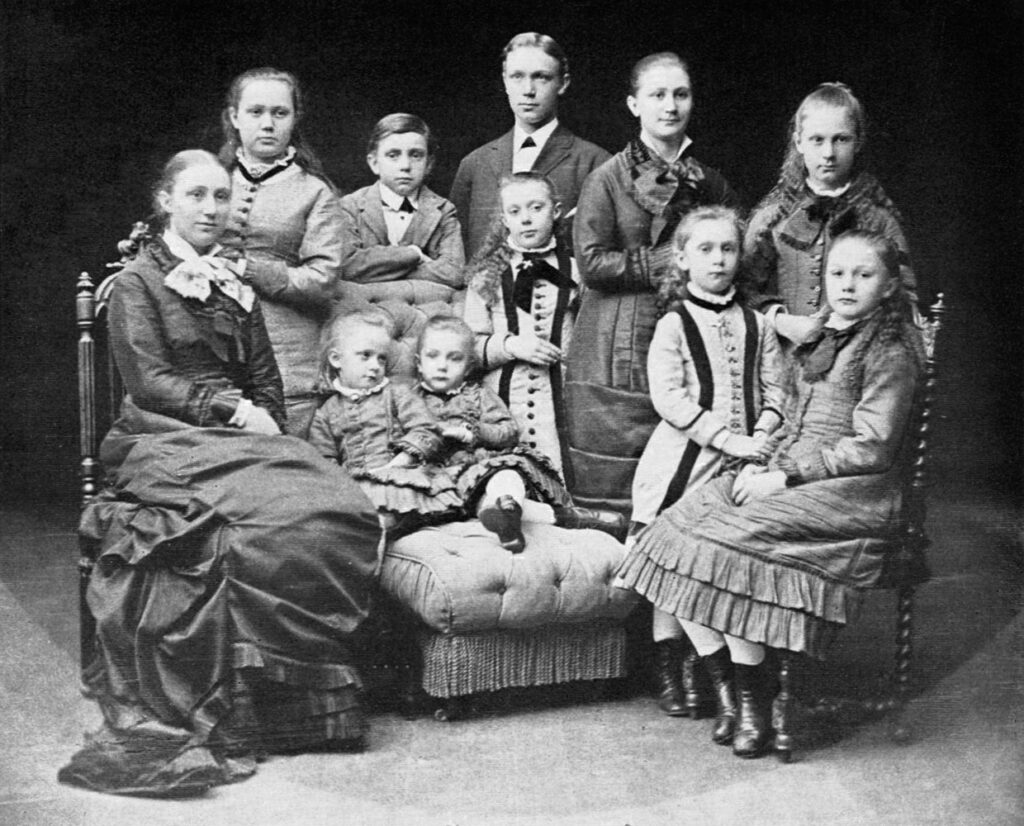In my view, history is rarely a straightforward process in which events are driven logically. Rather, twists and turns can cause events to veer off in new and unexpected directions. Complexity is always too great to predict or control. The history of PARSIFAL is no exception. In fact, the background to this story is, in many ways, as unlikely as the story itself.
My interest in history has been a constant throughout my life for as long as I can remember. However, one aspect of history was not present in my life until relatively recently – my own family history. I clearly remember the moment I became aware of it.
I was doing my military service in 1984 when we were given leave just before Christmas. Instead of going home, I decided to visit my aunt and uncle. Over a good dinner and a bottle of Beaujolais nouveau (the height of fashion in those days), we started discussing history, and my aunt began telling me the most fascinating history of my great-great-grandmother.
Downton Abbey on Steriods
My aunt told the story in a way that only she could, with the ability to illustrate major events with a multitude of details; a button sufficient to tell an entire story of heroism and self-sacrifice, a note written in an evening glove enough to capture the totality of my great-grandparents’ tragic love affair. Above all, she painted a picture of a family that, in short, might be described as Downton Abbey on steroids. Not just a wealthy family with three daughters, but instead 10 daughters and two sons. What’s more, the story was even more dramatic and colourful.
It involved the Mellgren family from Gothenburg, a family whose fortune was built on tobacco. There is a picture of all the Mellgren children taken in 1877, of which I had seen copies and which was about the only relevant thing I had seen before that evening. It was just a group of people dressed in old-fashioned clothes, but that evening they came alive to me.

The emergence of a wealthy family and matriarch
August Mellgren (born 1829) was the son of a Gothenburg merchant. In 1848, at the age of just 19, he took over his father’s tobacco company following his death. August was a pious man with a strong social conscience. In 1858, he met and married the deeply religious Hulda Hansson, daughter of Major Olof Hansson of the Royal Army. They had a happy marriage and were rewarded with 12 children, born between 1859 and 1876. Only one, Gerda, born in 1865, died young, which was unusual in an era when child mortality was still high and childbirth risky for women.
The tobacco business that August inherited from his father grew substantially amid Sweden’s rising prosperity as industrialisation became established in the country from the 1860s onwards. By 1877, the business had become a stable source of wealth, but then tragedy struck when August suddenly died at the age of 48. Hulda was left with their 11 children, the tobacco company with around 100 employees, and a large estate, Sollum, in the parish of Hjärtum some 56km northeast of Gothenburg (Interestingly, she inherited the estate from her father, as it was she, rather than her brother, who had the ability to manage it).
This was a lot for anyone to manage in an era when women were certainly not seen as independent, and entrepreneurial success was not a given. However, Hulda was an extraordinarily capable woman who continued to expand the business, and in 1893 she had the 10th-highest income of anyone in Gothenburg, Sweden’s second-largest city. She was certainly an unusual person and ahead of her time in many ways. Being a responsible employer, at least by the standards of her day, and knowing that with wealth comes responsibility, she donated money to fund a school and an orphanage. Hulda was also a strong leader and a carer for her family and her employees.
Nevertheless, the loss of a father weighed on the family, and, in an era when social security was unknown, it was critical to cooperate and support your family members. Hulda succeeded in instilling a strong sense of community among her many children, and this legacy has lasted to this day. In fact, this sense of solidarity has been critical to the progress of this research project.
A family history I thought I knew
In 1946, the oldest of the sisters, Marie-Louise Söderblom, decided to leave her inheritance to a family foundation, who’s primary purpose was to sustain my great-grandmother, Märta Rosengren, who had been a widow since the suicide of my great-grandfather in 1905. Upon her death in 1947, the remaining wealth was intended to support the needs of all the descendants of August and Hulda Mellgren. For many years, it provided support whenever there was need. Importantly, though, it financed a book entitled ‘August & Hulda Mellgrens ättlingar’ – ‘The Descendants of August & Hulda Mellgren’, which details all members of the family, along with short biographies. This appeared in 1964, just before I was born.
This book included everyone in the family; the famous, the wealthy, the not so wealthy, and those who would be unknown to most readers of this text. It listed both those alive at the time and the deceased, including those who had died tragic deaths. People with astonishingly adventurous lives, like my father’s uncle who nearly starved to death in Canada, men with illustrious military careers, entrepreneurs, civil servants, politicians and even a government minister. In short, everyone in the family, or so I thought for many years. Until I learned of a missing piece in the family puzzle.
A chance discovery
In 1948, a box was placed in the attic of Rosenlund, Björn Prytz’s summer residence. At that point, he had reached the end of an extraordinary career that had culminated in him being Sweden’s Minister Plenipotentiary to the United Kingdom from 1938 to 1947. He placed the box there as a precaution; he needed to be able to prove his actions, to document them if the need arose. The period in wartime London had been tough in many ways, and many a delicate matter had had to be managed.
Björn Prytz died on 22 June 1976 at his beloved Rosenlund at the age of 79. His box in the attic interested no one. It remained where it was as boxes tend to do. His second wife, Aino, born in 1903, outlived him by many years and died in 1997. In her later years, a distant relative of Björn, Gustav Krafft, had been helping her a lot, and, as an expression of gratitude, Aino gave Rosenlund to him. In 2015, the property was put up for sale, and, when Gustav was clearing out the house, Björn’s box resurfaced.
Our man in London
Gustav’s immediate reaction was to burn the material, in accordance with Björn’s wishes, but some friends of his, David Keiller and Johan Beckman, convinced him that the material was too important and valuable to be destroyed without further analysis. Gustav changed his mind as the first folder of documents was already on the fire. Instead, he handed the material to Professor Emeritus Martin Fritz at the University of Gothenburg, who had previously published extensively on Swedish industrial history and specifically on SKF, the ball-bearing manufacturer, of which Björn had been CEO from 1921 to 1936.
For more than a year, Martin had access to the full contents of the box with the aim of writing the first book on Björn Prytz’s tenure as ‘Sweden’s Minister to the UK’. The book was published in 2017 under the title ‘Vår man i London’ – ‘Our Man in London’. To date, it is only available in Swedish.
A missing piece that led to an extraordinary untold story
I discovered the book by chance in 2020 and, to my surprise, there is a chapter about Agneta Prytz (Björn’s second daughter) and Robert Tainturier. The only problem is that, according to the aforementioned book about the Mellgren family, Robert Tainturier does not exist. The excerpt below from ‘The Descendants of August & Hulda Mellgren’ mentions Björn and Ingrid Prytz and their three children, as well as Agneta’s very well-known husband Gösta Folke, a Swedish film and theatre director. Why is Robert missing?

This is a tale that becomes all the more mysterious from reading Martin’s book. That was in late 2020, and I then began my search for more information. At that point, Martin’s book was all I had to go on. However, after three years of hunting for details, I have collected around 2,000 documents, photographs, books, and magazine and newspaper articles. Do I know everything? No, definitely not. But it is possible to begin to piece together PARSIFAL, or the story of Agneta Prytz and Robert Tainturier. But to successfully conclude this project, dear reader, we may have to cooperate. This is, to all intents and purposes, an interactive venture.
